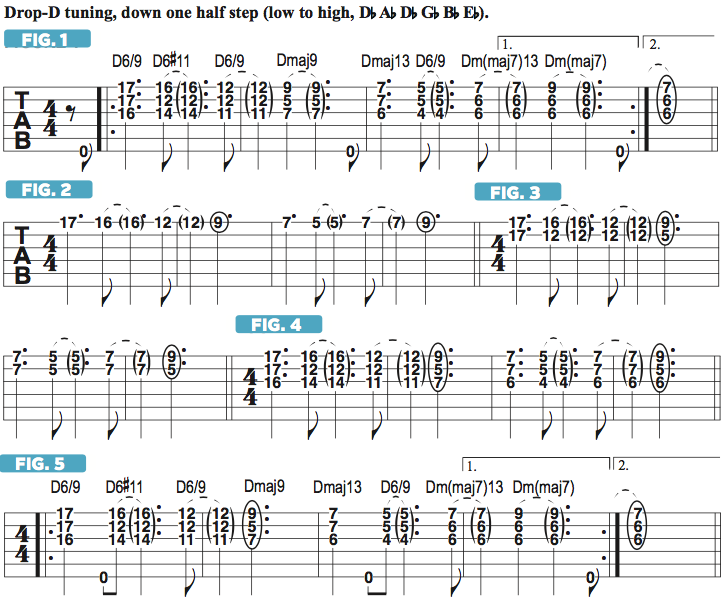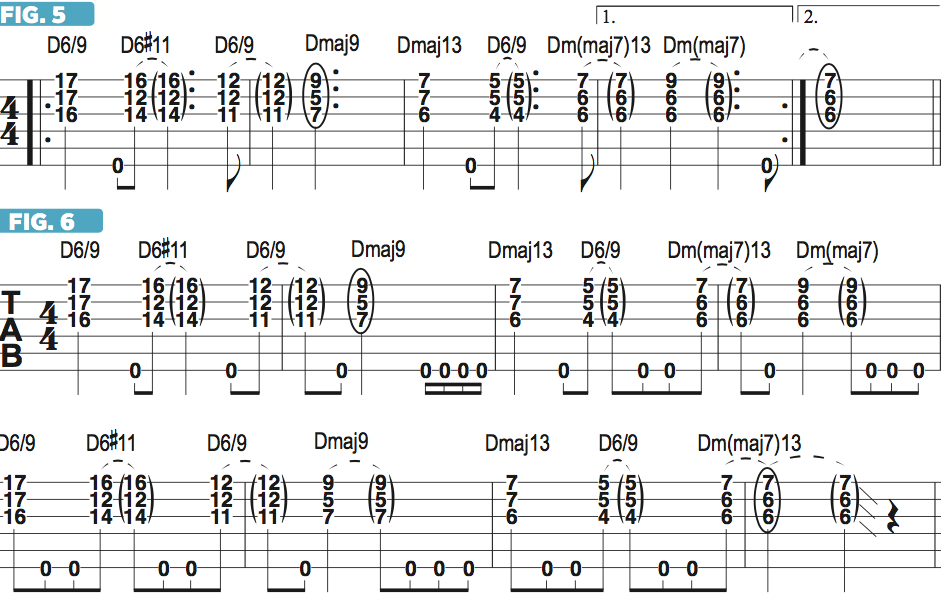Oftentimes, when composing progressive or complicated music, one can become a little wary that the finished product may not live up to the depth and density of the music of our favorite prog-metal bands. This style of music is often characterized by shifting rhythmic syncopations, odd meters and dense, polyphonic chords. I have occasionally found myself thinking, “How do I get started crafting music that will embrace these elements?”
When I write music, I like to begin in the simplest way possible, stripping the approach back to a melody so basic that it could be a child’s lullaby. This is precisely the approach I took in writing “Electric Sunrise,” a composition featured my 2016 album Handmade Cities.
FIGURE 1 presents one of the piece’s primary themes, which is built from six descending chord voicings, followed by two ascending voicings, all played over a sustained open low-D pedal tone. (My guitar is in drop-D tuning, down one half step: low to high, Db Ab Db Gb Bb Eb). As you can see by the chord names, the harmony gets a bit dense and polytonal.
The way I devised these chords was by first establishing the melodic line, played on the high E string, as depicted in FIGURE 2; I then harmonized the melody by adding notes below it on the B and G strings. As shown in FIGURE 3, each of the melodic notes is joined by another note on the string directly below it, with intervallic relationships that alternate between fourths—fretting both strings at the same fret on the top two strings—and sixths.
I then repeat this process when adding a third note to the harmonized melodic line, as illustrated in FIGURE 4, in this instance alternating between fourths and seconds. Looking at the notes on the B and G strings, I begin with E and B, respectively, which are a perfect fourth apart, followed by B and A, which are major second apart.

Virtually all of the notes here are derived from the D Lydian mode (D E F# G# A B C#), but in the last two bars of the phrase I add an unexpected twist by substituting the minor third, F, for the major third, Fs, which results in the formation of Dm(maj7) and Dm(maj7)13. These types of minor-third/major-seven chords evoke an unsettling sound based on this distinct polytonality.
To my mind, the most essential element in modern progressive music is what happens rhythmically, so let’s now phrase this harmonized melody with some rhythmic anticipation and syncopated accents, as shown on FIGURE 5. Once a guitar figure like this is clearly defined, it gives one a better idea of how to develop an arrangement with bass, drums, keyboards and vocals.
Get The Pick Newsletter
All the latest guitar news, interviews, lessons, reviews, deals and more, direct to your inbox!
I can now give this idea the full prog-metal treatment by adding distortion and ramping up the aggression of my pick attack, as demonstrated in FIGURE 6. As you can see, what started out as an innocent, almost childish melody developed into a grown-up prog-metal sound, via some sophisticated harmonization and aggressive rhythmic syncopations.











